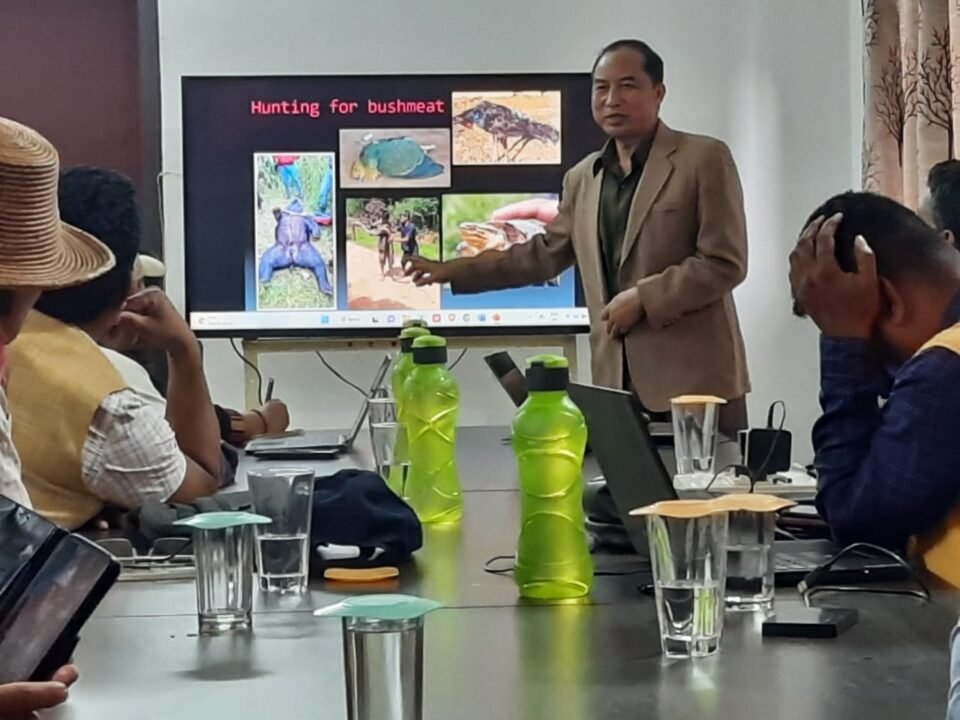The organisation signs an MoU with the Meghalaya Forest Department for biodiversity conservation, including mitigation of human and wildlife conflict
HT Correspondent
Tura, Sept 23: The State of Meghalaya harbours approximately 1,700 wild Asian elephants, but in recent years have witnessed an increase in human elephant conflict (HEC) incidents. During 2019-22, a total of 12 people succumbed to death in the State as a result of HEC. HEC negatively impacts both elephants and humans in the form of crop and property damage, loss of human lives and retaliatory killing of the elephants, which is undermining the conservation efforts to safeguard the elephants and human well-being.
This has prompted Aaranyak, a leading biodiversity conservation organisation to work in HEC affected areas to reduce the negative impact of HEC and promote coexistence. This has led to initiate a three-year project in collaboration with the British Asian Trust and with support from the Darwin Initiative in West Garo hills district in Meghalaya to enable human elephant coexistence. It is worth mentioning that Aaranyak has signed an MoU with the Meghalaya Forest Department for biodiversity conservation, including mitigation of human and wildlife conflict. Under this MoU, Aaranyak will work cohesively with the Meghalaya Forest Department to address the issue of HEC. Thus, the organisation will be working in six preselected villages of West Garo hills district. This ambitious project flagged off on Thursday with an inception workshop, organised in the Circuit House of Tura. The workshop was graced by Swapnil Tambe, IAS, deputy commissioner, West Garo Hills, Tura, Vikas Kumar, IPS, additional SP, West Garo Hills, Tura, SN Sangma, IFS, conservator of Forests (WL&T), Garo Hills Region, Tura, CA Sangma, MCS, BDO, Tikrikilla, West Garo Hills, RK Marak, DFO, East and West Garo Hills (Wildlife Division) and Government officials from various departments, representative of other organisations, Nokma Council, Students’s Union, and members of local communities.
The deputy commissioner Swapnil Tambe shared his insights and said, “The elephant corridors must be revived for long-term conservation”. He mentioned about convergence with different relevant agencies to facilitate coexistence.
While the Conservator of Forests (WL&T), SN Sangma gave glimpses of his experiences on human elephant conflict and how the Forest Department through various initiatives such as creation of 63 protection squads is facilitating in reduction of HEC. The additional SP Vikas Kumar too shared his experiences and observation on HEC and delved how enforcement agencies can help addressing the issues as well.
During the workshop the participants from six villages of the West Garo Hills district, namely Jamdamgre, Borogobol, Bandukmalli, Darensegre, Kharsingdap, Potamati and Bordupi were present and shared their thoughts and potential measures to resolve HEC. Dr Bibhuti Prasad Lahkar, a senior scientist with Aaranyak, presented a talk on the current HEC scenario in the State and highlighted that how through educating local communities, supplementing livelihood, and providing mitigation tools, Aaranyak plans to enable coexistence. Dr Alolika Sinha, Aaranyak’s conservationist, conducted the workshop, while Dr. Lahkar moderated the open discussion session. The team from Aaranyak consisting of Abhijit Boruah, Anjan Baruah, Jayanta Pathak and Gunajit Mazumdar’s efforts in organising the workshop is praise-worthy. Pradip Barman and Rupam Gayari provided support in organising the workshop. Aaranyak look forward to work cohesively with all the stakeholders to promote coexistence in the region.
For the unversed, the Elephant Research and Conservation Division of Aaranyak, a Scientific and Industrial Research Organisation recognised by the Ministry of Science and Technology, headquartered in Guwahati, has adopted multifaceted approaches to mitigate conflict with elephants. In Assam, Aaranyak has so far installed more than 80 km of solar-powered fences in HEC affected areas which have aided in promoting coexistence with these gentle giants. Besides, other initiatives to reduce HEC includes cultivation of crops that are less attractive to elephants, which at the same time supplement income as these ae cash-crops, outreach activities, creation of group of local volunteers- Elephant Conservation Network to monitor elephants and act as an early warning system, providing mitigation tools such as solar street-lights, complementing the efforts of anti-depredation squads, among other activities.







